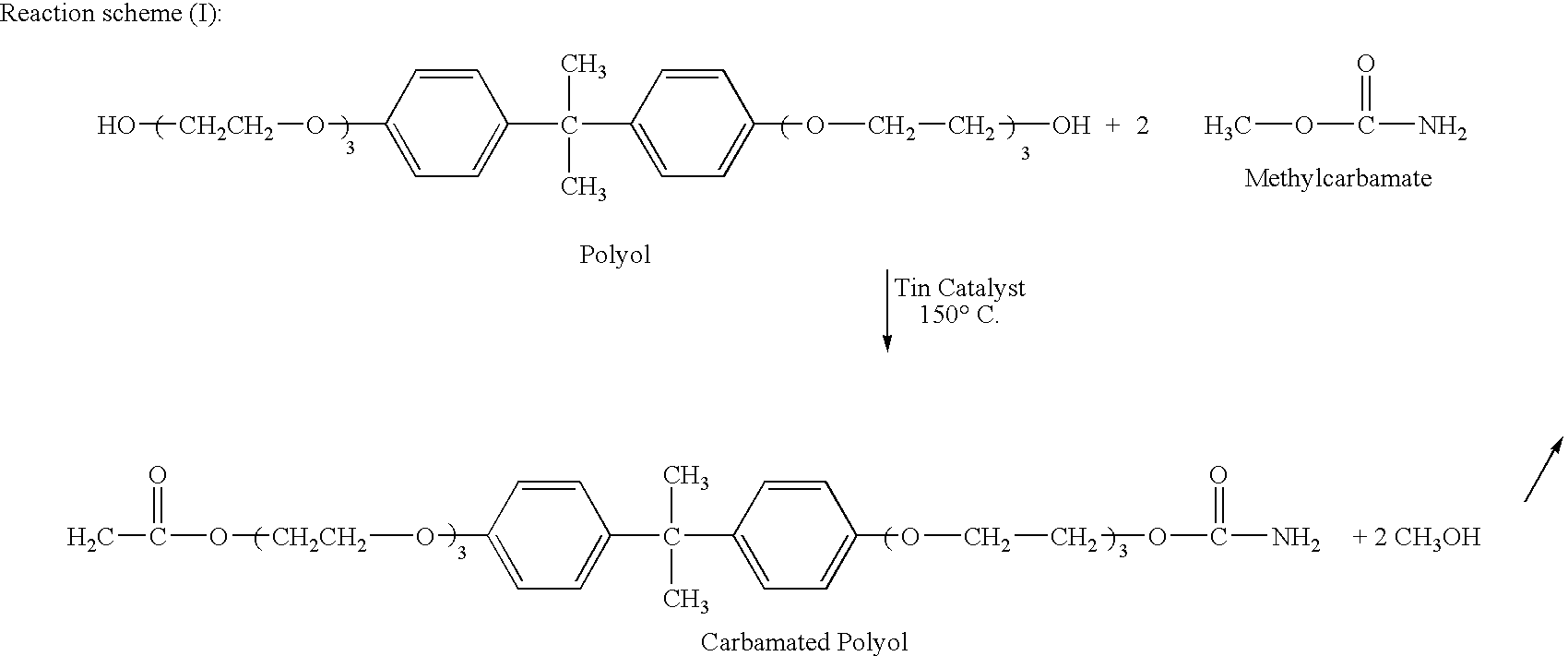Carbamated polyols, and compositions and methods using the same
a technology of carbamated polyols and compositions, applied in the field of coatings, can solve the problems of negative impact of water dispersibility of components on retort resistance, and achieve the effects of improving retort resistance, short pasteurization time, and long processing tim
- Summary
- Abstract
- Description
- Claims
- Application Information
AI Technical Summary
Benefits of technology
Problems solved by technology
Method used
Image
Examples
example 1
[0035]2392 grams (g) of Bisphenol A-Ethylene Oxide polyol (6:1 Bis A: EO, obtained from BASF as MACOL) were charged into a glass reactor equipped with a stirrer, thermocouple and a nitrogen inlet. To this, 725 g of molten methyl carbamate and 45.20 g of tin-based catalyst (obtained from Atochem as FASCAT 4215) were added. The reaction mixture was heated slowly to 135° C. to 140° C. and methanol was distilled off using a fractionating column. The reaction was continued until 245 g of methanol were collected. The extent of transcarbamation was monitored using IR. The reaction was considered complete when the hydroxyl IR peak had disappeared. To remove the unreacted methylcarbamate, 60 g of xylene were added slowly to the resulting reaction product. The xylene was removed under vacuum while the temperature of the batch was held between 140° C. and 165° C. When most of the xylene was removed and residual methyl carbamate was less than 1 percent, the reaction product was cooled to 90° C....
example 2
[0036]5577 g of Bisphenol A-Ethylene Oxide polyol (6:1 Bis A: EO) were charged into a glass reactor equipped with a stirrer, thermocouple and a nitrogen inlet. To this, 1704 g of molten methyl carbamate and 99.00 g of dibutyltin dilaurate were added. The reaction mixture was heated slowly to 135° C. to 140° C. and methanol was distilled off using a fractionating column. The reaction was continued until 545 g of methanol were collected. The extent of transcarbamation was monitored using IR. The reaction was considered complete when the hydroxyl IR peak had disappeared. To remove the unreacted methylcarbamate, 360 g of methyl ethyl ketone were added slowly and distilled off to remove residual methyl carbamate from the reaction mixture using vacuum and allowing the batch temperature to rise to 140° C. to 165° C. When most of the MEK has been removed and residual methyl carbamate was less than 1 percent, the reaction product was cooled to 90° C. 193 g of DMEA was added to lower the visc...
example 3
[0037]The procedure of Example 2 was repeated, but unreacted methyl carbamate was not removed. The resulting product had about 7 percent of residual methyl carbamate.
PUM
| Property | Measurement | Unit |
|---|---|---|
| temperature | aaaaa | aaaaa |
| humidity | aaaaa | aaaaa |
| molar ratio | aaaaa | aaaaa |
Abstract
Description
Claims
Application Information
 Login to view more
Login to view more - R&D Engineer
- R&D Manager
- IP Professional
- Industry Leading Data Capabilities
- Powerful AI technology
- Patent DNA Extraction
Browse by: Latest US Patents, China's latest patents, Technical Efficacy Thesaurus, Application Domain, Technology Topic.
© 2024 PatSnap. All rights reserved.Legal|Privacy policy|Modern Slavery Act Transparency Statement|Sitemap



